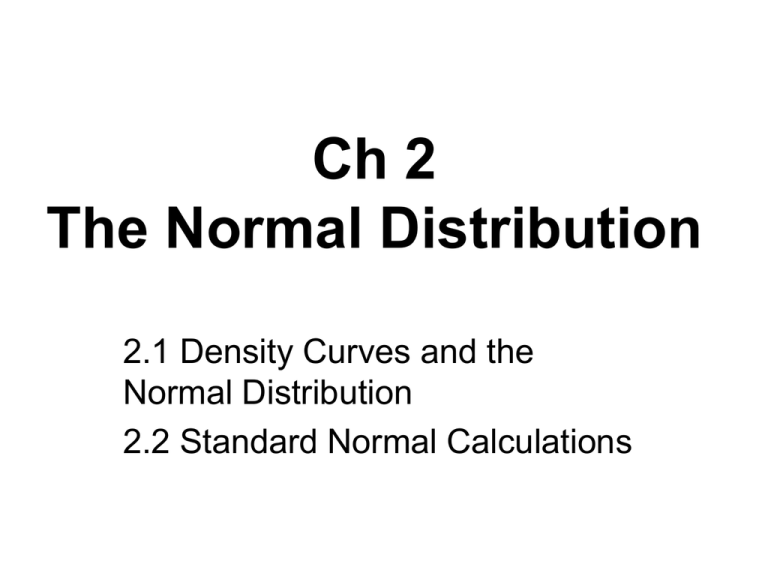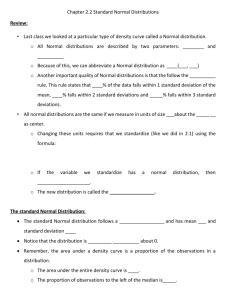Ch 2 The Normal Distribution
advertisement

Ch 2 The Normal Distribution 2.1 Density Curves and the Normal Distribution 2.2 Standard Normal Calculations • We have a clear strategy for exploring data on a single quantitative variable – Plot Data, usually Histogram or Stemplot – Calculate numerical summaries – Describe the CUSS • New step: – If the overall pattern is very regular (not necessarily symmetric), we can describe it with a smooth curve Density Curves • Easier to work with a smooth curve than with a histogram • The curve describes what proportions of the observations fall within each range of values • Total area under the curve is exactly 1 • Always on or above the horizontal axis Density Curves The shaded area is the proportion of observations taking values between 7 and 8 Median and Mean of Density Curve • Median – Equal-Areas Point. Half the area to its left and half its area to its right – Quartiles divide area into quarters • Mean – Balance point at which the curve would balance if it were made of solid material – Pulled towards skewing At which of these points on each curve do the mean and median fall? Median: B Median: A Median: B Mean: C Mean: A Mean: A New Notation • Density Curve is an idealized description of data. Must distinguish between mean and standard deviation of a density curve versus those of actual observations • Actual Observations: • Idealized distributions: mean: standard deviation: Normal Distributions • Normal Distributions: – Symmetric, Single-Peaked, Bell-Shaped – Always described by giving mean: standard deviation: (occur at inflection points) “Empirical” or “68-95-99.7” Rule For any normal distribution: • 68% of the observations fall within 1 standard deviation of the mean • 95% of the observations fall within 2 standard deviations of the mean • 99.7% of the observations fall within 3 standard deviations of the mean • 2.6 MEN’S HEIGHTS The distribution of heights of adult American men is approximately normal with mean 69 inches and standard deviation 2.5 inches. Draw a normal curve on which this mean and standard deviation are correctly located. 2.2 Standard Normal Calculations N ( , ) • We can “standardize” all normal distributions by measuring in units of size about the mean • Standardizing Observations If x is an observation from a distribution that has mean and standard deviation , then standardized value of x is z x Called z-score. The z-score tells us how many standard deviations the original observation falls from the mean and in which direction Standard Normal Distribution N(1,0) Standard Normal Table (Table A) • Ex: Find the proportion of observations from the standard normal table that are less than 2.22 0.9868 • Ex: The heights of young women are approximately normal N(64.5”,2.5”). Find the standardized height of a woman who is 68” tall. z x 68 64.5 z 2.5 z 1.4 • What proportion of women are less than 68” tall? About 0.9192 or 91.92% of women are less than 68” tall. • Ex: Cholesterol Level for 14 year old boys N(170,30). Levels above 240 may require medical attention. Units: cholesterol per deciliter of blood. – What % of 14 yr. old boys have more than 240 mg/dl cholesterol? 240 170 z 30 z 2.33 • Looking for proportions of values above 2.33. • Table A gives proportions below a z score. Can we still use the table to answer the question? Proportion of 14 yr. old boys with a cholesterol level greater than 240 is approx. .0099 or .99% • What proportion of 14 yr old boys have blood cholesterol between 170 and 240 mg/dl? • Looking for: 170 x 240 • Standardize both scores: 0 z 2.33 The proportion of boys have blood cholesterol between 170 and 240 is 0.4901 or about 49% • EX: Scores on the SAT Verbal follow N(505,110). To earn in the top 10% how high must a student score? Closest to 0.9 is 0.8997 which corresponds to z=1.28 x 505 1.28 110 x = 646….does this make sense in the context of the problem? Assessing Normality • Construct a histogram or stem-plot to verify bell shape • Calculate the percent of observations within 1 and 2 standard deviations from the mean and compare to empirical rule • Construct a normal probability plot using your calculator. If data is close to normal, plotted points will lie in close to a straight line. 2.26 CAVENDISH AND THE DENSITY OF THE EARTH Repeated careful measurements of the same physical quantity often have a distribution that is close to normal. Here are Henry Cavendish’s 29 measurements of the density of the earth, made in 1798. (The data give the density of the earth as a multiple of the density of water.) 5.50 5.61 4.88 5.07 5.26 5.55 5.36 5.29 5.58 5.65 5.57 5.53 5.62 5.29 5.44 5.34 5.79 5.10 5.27 5.39 5.42 5.47 5.63 5.34 5.46 5.30 5.75 5.68 5.85 (a) Construct a stemplot to show that the data are reasonably symmetric. (b) Now check how closely they follow the 68–95–99.7 rule. Find and s, then count the number of observations that fall between – s and s, between – 2s and 2s, and between – 3s and 3s. Compare the percents of the 29 observations in each of these intervals with the 68–95–99.7 rule. (c) Use your calculator to construct a normal probability plot











